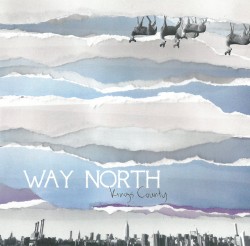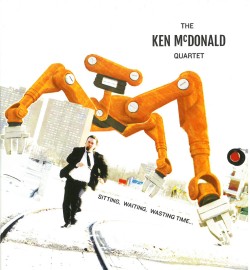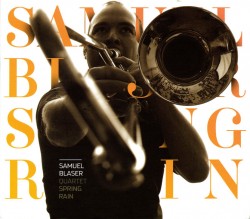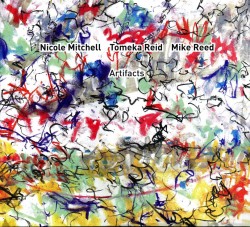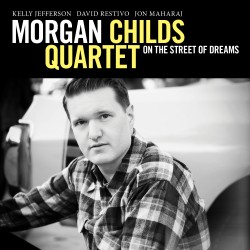Big Bands Redux
Although most people associate big bands with swing-era dances and later, jazzier, manifestations such as Nimmons ’n’ Nine and The Boss Brass, despite the dearth of venues and difficulties of keeping even a combo working steadily, musicians persist in utilizing large ensembles. Like muralists who prefer the magnitude of a large canvas, composers, arrangers and players appreciate the colours and breadth available using numerous, well-balanced instruments.
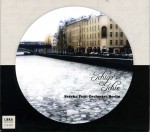 Case in point is Japanese pianist Satoko Fujii. Like a traveller who dons a new outfit when moving to a new locale, Fujii organizes a new big band. So Fujii, who recently relocated from New York to Berlin, debuts the 12-piece Orchestra Berlin (Libra Records 212 037 satokofujii.com), joining the large ensembles she already leads in New York, Tokyo and Nagoya. Although ABCD, the final track gives individuals solo space, including some dynamic string plucking and key-slapping vigour from Fujii, the disc’s showpiece is the extensive, but subtle sound-melding highlighted in the title suite. Treating the orchestra as one multi-hued instrument, most of the skillfully arranged climaxes have the seven brass and reed players operating as one undulating whole. At the same time, two drummers – Michael Griener and Peter Orins – keep themes on course during transitions with surging whitecap-like rhythms, buoyed by bassist Jan Roder’s robust walking. Brief, but zesty solos also appear like sophisticated scallops in the origami-like sound creation. For instance, Roder’s harsh thumps face off with trumpeter Natsuki Tamura on Ichigo Ichie 3, with the trumpeter later backing up to race guitarist Kazuhisa Uchihashi’s slurred fingering to a mountaintop-high plateau of interlocked timbres. Trombonist Matthias Müller’s yearning, plunger-moans cut through the rumbling thunder-like tension from the other horns on Ichigo Ichie 1; while tenor saxophonist Gebhard Ullmnan’s metal-shaking glissandi reach raw quivering excitement on Ichigo Ichie 2, with his solo complemented by gravelly trumpet grunts. Instructively, that track starts out with the group swinging as confidently as any traditional big band. All-in-all, Fujii’s pivotal talent coordinates radiant group motion plus stunning single showcases to create a challenging yet satisfying program.
Case in point is Japanese pianist Satoko Fujii. Like a traveller who dons a new outfit when moving to a new locale, Fujii organizes a new big band. So Fujii, who recently relocated from New York to Berlin, debuts the 12-piece Orchestra Berlin (Libra Records 212 037 satokofujii.com), joining the large ensembles she already leads in New York, Tokyo and Nagoya. Although ABCD, the final track gives individuals solo space, including some dynamic string plucking and key-slapping vigour from Fujii, the disc’s showpiece is the extensive, but subtle sound-melding highlighted in the title suite. Treating the orchestra as one multi-hued instrument, most of the skillfully arranged climaxes have the seven brass and reed players operating as one undulating whole. At the same time, two drummers – Michael Griener and Peter Orins – keep themes on course during transitions with surging whitecap-like rhythms, buoyed by bassist Jan Roder’s robust walking. Brief, but zesty solos also appear like sophisticated scallops in the origami-like sound creation. For instance, Roder’s harsh thumps face off with trumpeter Natsuki Tamura on Ichigo Ichie 3, with the trumpeter later backing up to race guitarist Kazuhisa Uchihashi’s slurred fingering to a mountaintop-high plateau of interlocked timbres. Trombonist Matthias Müller’s yearning, plunger-moans cut through the rumbling thunder-like tension from the other horns on Ichigo Ichie 1; while tenor saxophonist Gebhard Ullmnan’s metal-shaking glissandi reach raw quivering excitement on Ichigo Ichie 2, with his solo complemented by gravelly trumpet grunts. Instructively, that track starts out with the group swinging as confidently as any traditional big band. All-in-all, Fujii’s pivotal talent coordinates radiant group motion plus stunning single showcases to create a challenging yet satisfying program.
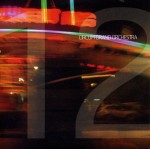 Tellingly, drummer Orins plus trumpeter Christian Pruvost – both of whom play in a quartet with Fujii – are two of the dozen players who make up the Lille-based Circum Grand Orchestra. But its 12 (Circum-Disc CD 1401 circum-disc.com), only resembles Orchestra Berlin in number not style. Just as sushi and pâté are wildly different concoctions, but both are food, so the CGO’s composer/leader, electric bassist Christoph Hache’s take on a big band differs from Fujii’s. Hache’s six tracks float rather than swing, but avoid being lightweight by anchoring the tunes with a rhythm section of piano, two guitars, two basses and two drummers. From the top, 12 constitutes a musical journey as a pre-recorded voice rhymes off itinerary stops. The pieces are also framed by their soloists. Graphic for instance slides awfully close to lounge music via Stefan Orins’ moderated piano licks plus wordless vocalizing from flugelhornist Christophe Motury. Even the subsequent tenor saxophone solo is so reminiscent of a lonesome night on a deserted street that it takes a tag-team effort from drummers Orins and Jean-Luc Landsweerdt to enliven the pace. On the other hand Padoc could be Peter and the Wolf re-imagined by Ozzy Osbourne, as a buoyant flute and bass clarinet stop-time duet twirls into rugged melody characterized by wide flanges and distortions from guitarists Sébastien Beaumont and Ivann Cruz, thick tremolo keyboard strides and undulating, accelerating saxophone splashes. Putting aside the toughness suggested by reed shrills, string reverb and percussion clobbering that underlines much of the music, the key to 12 is probably the title track. Like a model changing from an outfit of raw wool to one of sleek silk, the romantic continuum suggested by the graceful dual flugelhorn introduction is swiftly coloured with streaming counterpoint from the reeds and rhythm section, before retreating to dual flute sonata-like patterns and climaxes that highlight both interpretations in symmetrical fashion.
Tellingly, drummer Orins plus trumpeter Christian Pruvost – both of whom play in a quartet with Fujii – are two of the dozen players who make up the Lille-based Circum Grand Orchestra. But its 12 (Circum-Disc CD 1401 circum-disc.com), only resembles Orchestra Berlin in number not style. Just as sushi and pâté are wildly different concoctions, but both are food, so the CGO’s composer/leader, electric bassist Christoph Hache’s take on a big band differs from Fujii’s. Hache’s six tracks float rather than swing, but avoid being lightweight by anchoring the tunes with a rhythm section of piano, two guitars, two basses and two drummers. From the top, 12 constitutes a musical journey as a pre-recorded voice rhymes off itinerary stops. The pieces are also framed by their soloists. Graphic for instance slides awfully close to lounge music via Stefan Orins’ moderated piano licks plus wordless vocalizing from flugelhornist Christophe Motury. Even the subsequent tenor saxophone solo is so reminiscent of a lonesome night on a deserted street that it takes a tag-team effort from drummers Orins and Jean-Luc Landsweerdt to enliven the pace. On the other hand Padoc could be Peter and the Wolf re-imagined by Ozzy Osbourne, as a buoyant flute and bass clarinet stop-time duet twirls into rugged melody characterized by wide flanges and distortions from guitarists Sébastien Beaumont and Ivann Cruz, thick tremolo keyboard strides and undulating, accelerating saxophone splashes. Putting aside the toughness suggested by reed shrills, string reverb and percussion clobbering that underlines much of the music, the key to 12 is probably the title track. Like a model changing from an outfit of raw wool to one of sleek silk, the romantic continuum suggested by the graceful dual flugelhorn introduction is swiftly coloured with streaming counterpoint from the reeds and rhythm section, before retreating to dual flute sonata-like patterns and climaxes that highlight both interpretations in symmetrical fashion.
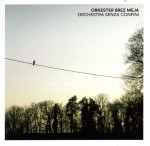 It’s hard not to envision symmetry when dealing with Orkester Brez Meja/Orchestra Senza Confini (Dobialabel dobialabel.com). As the title indicates this 17-piece ensemble was spawned by merging the Italian Orchestra Senza Confini (OSC) with the Slovenian Orkester Brez Meja (OBM), as Slovenian drummer Zlatko Kaučič and Italian bassist Giovanni Maier share composing and conducting credits. Magari C’È the second and final track is skittishly volatile, notable for its consolidation of magisterial beats from drummers Marko Lasić and Vid Drašler as well as crisscross alto saxophone riffs from Gianfranco Agresti and trumpeter Garbriele Cancelli’s carillon-like pealing. But in reality it’s an extended coda to Brezmejniki, the nearly 32-minute narrative that precedes it that defines the disc. As Brezmejniki moves in a rewarding chromatic fashion, like sophisticated surgeons during a difficult operation who allow appropriate anesthesia or incisions as necessary, the co-conductors add and subtract soloists. At points, one of the three tenor saxophonists erupts into a crescendo of honking tones; angled string strokes and jerky flutter tones arise from three double bassists; a cellist evokes contrapuntal challenges; and soothing harmonies result from Paolo Pascolo’s celestially pitched flute. Sometimes vocalist Elisa Ulian sounds distant gurgles; elsewhere, Adriatic-style scatting. Throughout, while certain rock music-like rhythms are heard, the sound perception is of looming storm clouds, conveyed by the ensemble resonating calculated accents and wrapped up by crunching bass and drum patterns that rein in and concentrate the horns into a time-suspended dynamic finale.
It’s hard not to envision symmetry when dealing with Orkester Brez Meja/Orchestra Senza Confini (Dobialabel dobialabel.com). As the title indicates this 17-piece ensemble was spawned by merging the Italian Orchestra Senza Confini (OSC) with the Slovenian Orkester Brez Meja (OBM), as Slovenian drummer Zlatko Kaučič and Italian bassist Giovanni Maier share composing and conducting credits. Magari C’È the second and final track is skittishly volatile, notable for its consolidation of magisterial beats from drummers Marko Lasić and Vid Drašler as well as crisscross alto saxophone riffs from Gianfranco Agresti and trumpeter Garbriele Cancelli’s carillon-like pealing. But in reality it’s an extended coda to Brezmejniki, the nearly 32-minute narrative that precedes it that defines the disc. As Brezmejniki moves in a rewarding chromatic fashion, like sophisticated surgeons during a difficult operation who allow appropriate anesthesia or incisions as necessary, the co-conductors add and subtract soloists. At points, one of the three tenor saxophonists erupts into a crescendo of honking tones; angled string strokes and jerky flutter tones arise from three double bassists; a cellist evokes contrapuntal challenges; and soothing harmonies result from Paolo Pascolo’s celestially pitched flute. Sometimes vocalist Elisa Ulian sounds distant gurgles; elsewhere, Adriatic-style scatting. Throughout, while certain rock music-like rhythms are heard, the sound perception is of looming storm clouds, conveyed by the ensemble resonating calculated accents and wrapped up by crunching bass and drum patterns that rein in and concentrate the horns into a time-suspended dynamic finale.
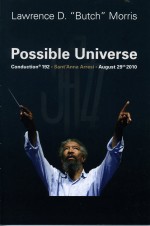 Kaučič’s and Maier’s project uses conduction, which is directing improvisation through gestures. Lawrence “Butch” Morris (1947-2013) originated the concept and Possible Universe (NBR SA Jazz 014 jtdistribution.net), a newly released session from the Italian Sant’Anna Arresi Jazz Festival in 2010, confirms its skillful application. This eight-part suite by a 15-piece European-American band encompasses hushed impressionism and hard-rocking with the same aplomb. Like a theatre director, Morris knows when to scene-set the proceedings with moderate polyphonic insouciance and when to have soloists let loose with dramatic emotions. Floating ensemble tones dominate Possible Universe part two for instance before giving way to a slurry Ben Webster-style tenor saxophone solo. Supple patterning from percussionists Hamid Drake and Chad Taylor maintains the linear theme on Possible Universe part four, even as kinetic plinks and jitters from guitarists Jean-Paul Bourelly and On Ka’a Davis threaten to rip it apart. Lumbering grace is imparted as the ensemble members improvise in unison, with sophisticated dabs from Alan Silva’s synthesizer adding a contrapuntal continuum. Spectacularly, one curtain-call-like climax occurs on Possible Universe part seven. David Murray’s ocean-floor-deep bass clarinet smears create the consummate intermezzo between the entire band’s upwards-floating crescendo that precedes it and theme variations on the final track. At nearly 13 minutes, lengthier than anything that precedes it, Possible Universe part eight quivers with a semi-classical romanticism through affiliated cadenzas from the guitars, double basses and Silva’s synth’s string setting, even as atonal splutters from Evan Parker’s tenor saxophone and an equivalent blues-based line from Murray’s tenor saxophone struggle for dominance against the two trumpeters and one trombonist’s brassy explosions. Following numberless theme variations at different pitches, volumes and speeds from nearly every player, the finale is a calming timbre consolidation.
Kaučič’s and Maier’s project uses conduction, which is directing improvisation through gestures. Lawrence “Butch” Morris (1947-2013) originated the concept and Possible Universe (NBR SA Jazz 014 jtdistribution.net), a newly released session from the Italian Sant’Anna Arresi Jazz Festival in 2010, confirms its skillful application. This eight-part suite by a 15-piece European-American band encompasses hushed impressionism and hard-rocking with the same aplomb. Like a theatre director, Morris knows when to scene-set the proceedings with moderate polyphonic insouciance and when to have soloists let loose with dramatic emotions. Floating ensemble tones dominate Possible Universe part two for instance before giving way to a slurry Ben Webster-style tenor saxophone solo. Supple patterning from percussionists Hamid Drake and Chad Taylor maintains the linear theme on Possible Universe part four, even as kinetic plinks and jitters from guitarists Jean-Paul Bourelly and On Ka’a Davis threaten to rip it apart. Lumbering grace is imparted as the ensemble members improvise in unison, with sophisticated dabs from Alan Silva’s synthesizer adding a contrapuntal continuum. Spectacularly, one curtain-call-like climax occurs on Possible Universe part seven. David Murray’s ocean-floor-deep bass clarinet smears create the consummate intermezzo between the entire band’s upwards-floating crescendo that precedes it and theme variations on the final track. At nearly 13 minutes, lengthier than anything that precedes it, Possible Universe part eight quivers with a semi-classical romanticism through affiliated cadenzas from the guitars, double basses and Silva’s synth’s string setting, even as atonal splutters from Evan Parker’s tenor saxophone and an equivalent blues-based line from Murray’s tenor saxophone struggle for dominance against the two trumpeters and one trombonist’s brassy explosions. Following numberless theme variations at different pitches, volumes and speeds from nearly every player, the finale is a calming timbre consolidation.
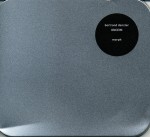 However, the most unconventional use of a big band here is on Morph (Confront ccs 37 confrontrecordings.com). Swiss-born, Paris-based tenor saxophonist Bertrand Denzler’s composition for Paris’ ONCEIM ensemble is a hypnotic, structured drone that transforms the entire group into a solid mass of tremulous polyphony. Considering that the length of the piece – 29 minutes – is actually one numeral less than the total players – 30 – Denzler’s skill in uniting tones and suppressing bravado is unsurpassed. Simultaneously acoustic and electric, Morph is all of a piece, but like the finest wine additionally manages to hint at other sonic flavours from the brass, reeds, strings, percussion and electronics. Three-quarters of the way though, the pace speeds up infinitesimally but distinctively, adding more tinctures of sound. A single guitar string strum is heard in the penultimate minutes as the timbres align more closely, uniting into a murmur that’s lively, seductive and tranquilizing.
However, the most unconventional use of a big band here is on Morph (Confront ccs 37 confrontrecordings.com). Swiss-born, Paris-based tenor saxophonist Bertrand Denzler’s composition for Paris’ ONCEIM ensemble is a hypnotic, structured drone that transforms the entire group into a solid mass of tremulous polyphony. Considering that the length of the piece – 29 minutes – is actually one numeral less than the total players – 30 – Denzler’s skill in uniting tones and suppressing bravado is unsurpassed. Simultaneously acoustic and electric, Morph is all of a piece, but like the finest wine additionally manages to hint at other sonic flavours from the brass, reeds, strings, percussion and electronics. Three-quarters of the way though, the pace speeds up infinitesimally but distinctively, adding more tinctures of sound. A single guitar string strum is heard in the penultimate minutes as the timbres align more closely, uniting into a murmur that’s lively, seductive and tranquilizing.
Hearing any of these sessions easily demonstrates that contemporary large group compositions and arrangements have long surpassed Moonlight Serenade or Take the A Train to plot and meet individual challenges.
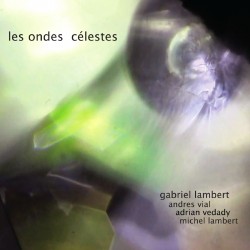 Les Ondes Célestes
Les Ondes Célestes

